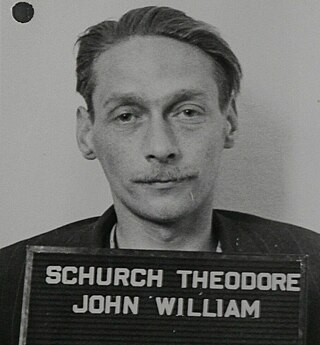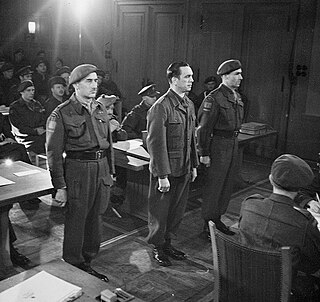
El Alamein is a town in the northern Matrouh Governorate of Egypt. Located on the Mediterranean Sea, it lies 106 kilometres (66 mi) west of Alexandria and 300 kilometres (186 mi) northwest of Cairo.
A court-martial or court martial is a military court or a trial conducted in such a court. A court-martial is empowered to determine the guilt of members of the armed forces subject to military law, and, if the defendant is found guilty, to decide upon punishment. In addition, courts-martial may be used to try prisoners of war for war crimes. The Geneva Conventions require that POWs who are on trial for war crimes be subject to the same procedures as would be the holding military's own forces. Finally, courts-martial can be convened for other purposes, such as dealing with violations of martial law, and can involve civilian defendants.

Edward Donald Slovik was a United States Army soldier during World War II and the only American soldier to be court-martialled and executed for desertion since the American Civil War. Although over 21,000 American soldiers were given varying sentences for desertion during World War II, including 49 death sentences, Slovik's death sentence was the only one that was carried out.

Execution by firing squad, in the past sometimes called fusillading, is a method of capital punishment, particularly common in the military and in times of war. Some reasons for its use are that firearms are usually readily available and a gunshot to a vital organ, such as the brain or heart, most often will kill relatively quickly.
The Commando Order was issued by the OKW, the high command of the German Armed Forces, on 18 October 1942. This order stated that all Allied commandos captured in Europe and Africa should be summarily executed without trial, even if in proper uniforms or if they attempted to surrender. Any commando or small group of commandos or a similar unit, agents, and saboteurs not in proper uniforms who fell into the hands of the German forces by some means other than direct combat, were to be handed over immediately to the Sicherheitsdienst for immediate execution.

The Ardeatine massacre, or Fosse Ardeatine massacre, was a mass killing of 335 civilians and political prisoners carried out in Rome on 24 March 1944 by German occupation troops during the Second World War as a reprisal for the Via Rasella attack in central Rome against the SS Police Regiment Bozen the previous day.
Eric Skeffington Poole was a British Army soldier who was the first commissioned officer to be executed by British military authority during World War I.

The Execution of Private Slovik is a nonfiction book by William Bradford Huie, published in 1954, and an American television movie that aired on NBC on March 13, 1974. The film was written for the screen by Richard Levinson, William Link, and director Lamont Johnson; the film stars Martin Sheen, and also features Charlie Sheen in his second film in a small role.

The Hastings and Prince Edward Regiment is a Primary Reserve infantry regiment of the Canadian Army. The regiment is part of 33 Canadian Brigade Group, one of four brigade groups of 4th Canadian Division. The regimental headquarters and one company are at 187 Pinnacle Street in Belleville and on Willmott Street in Cobourg, with another rifle company in Peterborough. The Peterborough Armoury houses what was traditionally B Company or Moro Company. Moro Company also serves as the headquarters for the regiment’s Assault Pioneer Platoon. Normally, the regiment deploys as a composite, Ortona Company, while the headquarters and administration form Somme Company.
Norton Cecil Michael Knatchbull, 6th Baron Brabourne, was a British peer and soldier, the son of The 5th Baron Brabourne, Governor of Bengal.

Theodore William John Schurch was a British soldier who was executed under the Treachery Act 1940 after the end of the Second World War. He was the last person to be executed in Britain for an offence other than murder.

The use of capital punishment by the United States military is a legal punishment in martial criminal justice. Despite its legality, capital punishment has not been imposed by the U.S. military in over sixty years.

Execution is a 1958 war novel by Canadian novelist and Second World War veteran Colin McDougall (1917–1984). Although it won McDougall the 1958 Governor General's Award for English-language fiction, it was his only novel, and after publishing it to wide acclaim he retreated into a quiet life as Registrar of McGill University in Montreal. Nevertheless, Execution stands with Timothy Findley's The Wars and Hugh MacLennan's Barometer Rising as one of the most widely read and studied Canadian war novels of the twentieth century.
Colin Malcolm McDougall (1917–1984) was a Canadian author best known for his 1958 Governor General's Award-winning novel Execution.

A Keen Soldier: The Execution of Second World War Private Harold Pringle by Andrew Clark is a historical study of the only execution of a Canadian soldier for military crimes committed during the Second World War. Harold Pringle was executed for murder shortly after the conclusion of the war in Europe. A Keen Soldier was published by Vintage Canada in 2002. It was a finalist for Canada's Governor General's Literary Award for non-fiction in 2003.

The Massacre of the Acqui Division, also known as the Cephalonia massacre, was a war crime by German soldiers against POWs of the Italian 33rd Infantry Division "Acqui" on the island of Cephalonia, Greece, in September 1943, following the Italian armistice during the Second World War. About 5,000 soldiers were executed, and around 3,000 more drowned.

The Cassino War Cemetery is a war grave cemetery in the commune of Cassino, Province of Frosinone, 139 kilometres (86 mi) south-east of Rome, Italy.

The 65th Infantry Division was a German division in World War II. It was formed in July 1942.

The Normandy massacres were a series of killings in-which approximately 156 Canadian and two British prisoners of war (POWs) were murdered by soldiers of the 12th SS Panzer Division during the Battle of Normandy in World War II. The majority of the murders occurred within the first ten days of the Allied invasion of France. The killings ranged in scale from spontaneous murders of individual POWs, to premeditated mass executions involving dozens of victims. Colonel Kurt Meyer, a commander in the 12th SS Panzer Division, was the only perpetrator charged for his role in the atrocities.














